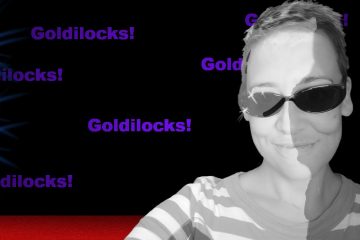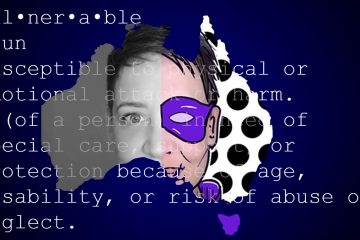I’m Goldilocks (every now and then I become Epilepsy Goldilocks); I’m a Superhero; and I’m also a VNS robot. I’d not even heard of a Vagus Nerve Stimulator (VNS) until a bitterly cold, snowy day in London, February 2018. I was at the National Hospital for Neurology and Neurosurgery (NHNN) for an appointment with a neurosurgeon who (although I didn’t realise at the time) was about to change my life.
But here’s probably not the right place to start; let’s rewind a little.
I was diagnosed with epilepsy at 13, though it’s highly likely I’ve been having seizures since I was wearing-teeny-tiny-clothes-little (don’t panic this isn’t gonna be my life-story, just the highlights). I’ve been around and around the medication merry-go-round several times, trying different drugs in varying combinations and dosages. After nearly 3 decades I’m still having focal impaired awareness seizures every 2-3 days.
The medics call this type of epilepsy ‘refractory epilepsy’ or (in less scientific terminology) ‘f*ck*d if we can do anything about it’. Well, in all honesty I have ‘idiopathic refractory epilepsy’ or (in less medical jargon) ‘b*gg*r*d if we know why and f*ck*d if we can do anything about it’.
So, in October 2017, when my consultant neurologist referred me to the top bods at University College London Hospital (UCLH) to discuss surgery, I was over-the-moon. In 3 decades of being treated for this condition no one had even whispered the word surgery. I knew my epilepsy wasn’t going away. But this kind of intervention meant I just might, perhaps (maybe) have a chance at bringing it under control?
I had a stack of tests, all the usual suspects: MRI, CT and an ambulatory EEG (which are so much fun, said no one ever!). For those who haven’t had the pleasure of one of these, it’s the uncomfortable experience of having wires (attached to a portable EEG machine) attached to your bonce. Should a seizure occur the EEG catches it, which hopefully in some way helps the docs determine where in your brain your seizures start.
The docs went through my files, looked and then looked again at the piccies (which mean nothing to me, but they seem to be able to discern things from them), and I was invited, while that February blizzard was raging, up to the NHNN. It was during this appointment I was offered the opportunity to have a Vagus Nerve Stimulator implanted.
Then, of course, the nice doctor described to me, slowly, what one of those was.
It was explained that a small device, much like a pacemaker, would be placed under my skin just above my left boob (not a Daniel Day Lewis movie, don’t get confused). It would have wires attached to it which would be fed, under my skin, up my neck and attached to the vagus nerve. The device then sends electrical impulses up the nerve and into my brain to steady the unpredictable misfirings of my roguish neurons. All of this would be done with the aim of reducing both the number and severity of my seizures.
I was elated.
The doctors didn’t want a response straight away, it’s important a decision like this is made following earnest thought and discussion. I was wavering on the side of ‘yes, yes, now, when can you do it?’. There was no need to drag out the chats with my family. Each of them in their own way said whichever option I chose they would support. They’re all aware of how much this condition affects my quality of life.
On 1 September 2018 at the NHNN on Queens Square, I had the surgery. I arrived on a Friday afternoon and was told, pretty much straight away the procedure would be the following morning. In many ways I was relieved it happened like this. If I’d been given an appointment date at ‘some point in the near-distant future’, I would’ve been way more stressed out.
The following morning, I was whisked away to the lab to become a VNS Robot. The oddest thing about that morning was I wasn’t nervous, no butterflies, no anguish, no nothing. My sisters will tell you my first go-to is usually panic. Yet I was eerily calm. It wasn’t the anaesthetic that was being pumped through my veins. I’d got to grips with having what’s basically a battery placed inside my chest because of the sheer amount of possibility it holds.
Yet, I knew the odds were small, the docs made sure I knew that before I got anywhere near an operating table.
The VNS isn’t a cure; it won’t take epilepsy away. UCLH divides the patients having a VNS into three groups: a third of them will get more than 50% reduction in seizures; a third of them get less than 50% reduction in seizures and in a third of them it won’t make any difference at all.
My surgery went well. I was officially bionic and would now (or at least after it was switched on) set off the scanners at airports.
The nurses at the hospital were awesome; they were reassuring and most likely a huge part of why I’d been so relaxed for the operation. That’s where I feel the support for this procedure ended. With regards to side-effects I’m of the opinion – and remember this entire blog is just that – forewarned is forearmed.
The letter I was sent by the consultant neurosurgeon explained:
‘When the device is stimulating, you will feel a tickling sensation at the back of your throat, changes in the tone of your voice and a coughing sensation; most of the patients tend to get used to this very quickly.’
It didn’t say anything else with regards to side-effects, at all. I didn’t even think about it at the time (I just didn’t know it needed thinking about). A month later the stimulator first increased its dosage, as I knew it was going to, automatically. What concerned me was (at that relatively low dose) it was far from ‘a ticklish sensation’ I felt at the back of my throat. I would go so far as to say, at some points in the day, it was borderline pain.
I appreciate that pain is subjective: my ‘hurts like hell’ might be your ‘no worries’. Yet, it would’ve been helpful to have an entire picture of what the surgery meant. I would’ve liked to have known what I was ‘in for’, to have been able to make an informed decision. So, I turned to the internet (generally a bad idea) to find more information concerning side-effects of a VNS.
I was both relieved and satisfied to find data from the Mayo Clinic which states that side-effects can include: voice changes; hoarseness; throat pain; cough; headaches; chest pain; breathing problems especially during exercise; difficulty swallowing; abdominal pain or nausea; tingling or prickling of the skin and insomnia. Although I appreciate this is a long and scary list, I stand behind my ‘forewarned is forearmed’ statement. I’d rather have known.
Dmitrij, my VNS nurse, had agreed (after a little coaxing) to program my implant to increase every two weeks. I have (and TBH I’m weirdly chuffed by this) the latest model stimulator: THE 1000! I‘ve no idea what this actually means, other than it’s the poshest, the smallest and I didn’t have to return to London for my settings to be increased. (It also means I get to tell people I’ve been re-programmed from 155 kilometres away.)
The VNS was activated on 19 September 2018 and increased .25mA every 2 weeks. It was set to ‘go off’ every 5 minutes for 30 seconds and the first increase was quite a shock. It doubled in output and I had no frame of reference for what I was feeling. The next increase (although amplified by the same amount) didn’t feel quite so bad, I was prepared. From then on, each fortnight, on a Wednesday I would sit and wait. I’d learned very quickly I didn’t like it to creep up on me.
The process continued through October and most of November. It increased each time by .25mA and each time I’d take just a little bit longer to adjust. I would adapt to it and ultimately assimilate to the new output. I’d forget about it; like you forget you’re wearing glasses because you’re used to them.
Until it increased to 1.25 on November 14, 2018.
From here onwards I became the type of person I try extremely hard not to be. I was in a lot of pain, especially in my jaw (bizarrely). I made an appointment with my dentist. He suggested as my pain was only when the VNS was stimulating, it ‘may be beneficial to have my wisdom teeth extracted. But not to do that until I am on a ‘level’ setting’. G. told me several times to call Dmitrij and say something, but I didn’t listen. I wasn’t (only) being stubborn, I was desperate for the VNS to be a success.
I was popping codeine, ibuprofen and paracetamol like Smarties. It was the nausea that was unbearable. Eventually, I did what I’d tried to avoid and taped the magnet over the scar on my chest (doing this turns the VNS off). Instant relief. Pain I can handle. Nausea I can deal with for a limited (an extremely limited) amount of time. However, it was the knowledge it was going to increase in 2-weeks, again 2-weeks after that and get worse which tipped me over the edge.
I rang my nurse at the NHNN and was given the next available appointment; I was overjoyed. The quality of care given was outstanding. I walked into the appointment with an incredibly long list of questions. Dmitrij took the time to answer every single one. He ensured I didn’t leave until I was comfortable with the VNS setting, and happy with the follow-up plan.
Unfortunately, many of my questions (I feel) should’ve been answered by the surgeon, way back in February 2018, when I was initially offered the surgery. I should’ve been fully apprised of the VNS and its implications back then. I would’ve still gone ahead; I would’ve also understood what was going to happen (physically, and emotionally) after every increase.
It wasn’t clear why this thing in my chest, which appeared (to me) binary (it’s on or it’s off, right?) has a cumulative effect on the brain and its chemical make-up. Dmitrij explained it all. This shouldn’t have been necessary with someone who was 3 months post-surgery. I should’ve known before I got 2 scars and a sh*t-load of nausea!
It’s now June 2020. I’ve been bionic for almost 2-years; that’s a pretty significant anniversary for us VNS Robots. From around the 2-year mark we can start looking through old seizure diaries to tally up whether we’re now having fewer seizures. However, it became clear (fairly quickly) to my treatment team and I that my awfully-over-excitable brain is extraordinarily sensitive to the electrical pulses the VNS discharges.
Or, to put it another way, the VNS needed to be placed on a setting that wasn’t too high, wasn’t too low (do you get where I’m going with this?), it had to be just right! It was going to take myriad tweaking, tinkering and fiddling-about-with, it was going to take time, but we were getting there.
But we’ll save that adventure for next week.
Because having epilepsy is like being Goldilocks: you can’t have too much, you can’t have too little; everything has to be just right.
Copyright © Jo Mackenzie 2020



2 Comments
S-dawg · November 28, 2020 at 1:48 PM
Have you been able to decrease your seizure meds, or are they still necessary? I’d love to get off of Vimpat, since is over $900 a month, but I have a feeling that the meds are still going to be a part of my daily regime.
Jo Mackenzie · November 29, 2020 at 2:31 AM
Hi, thank you so much for reading the post, it means a lot! I have had the VNS implanted for over two years now and am only just starting to reduce my medication. It will be a slow process, and perhaps not a successful one – we’re all just so different.